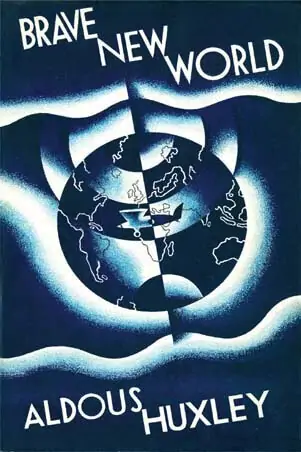Can Brave New World’s Sensual Cinema Turn Us on Today?
Aldous Huxley’s Feelies could inspire a new moviegoing experience.
 |
“Going to the Feelies this evening, Henry?” enquired the Assistant Predestinator. “I hear the new one at the Alhambra is first-rate. There’s a love scene on a bearskin rug; they say it’s marvellous. Every hair of the bear reproduced. The most amazing tactual effects.”
—Brave New World, Aldous Huxley
Always about the bearskin rugs!
We have a long-standing fascination with cinema. Whether joined together in the holy communion of gaze in a theatre—or now enjoyed in the comfort of our own homes—moving pictures, movies, DVDs, clips, and Youtube have intrigued us since their inception. And ever since we set eyes on “The Horse in Motion” by Eadweard Muybridge in 1878, we have wanted to push this medium further and further.
And by the first further, I mean to include sex. And by the second further, I mean sex you can feel.
Throughout history, whenever humans have discovered new media for personal expression, we’ve quickly incorporated sex into our expressions. Cave paintings, sculpture, drawings, literature—all have been used for distinctly sexual purposes. The same goes for film.
As soon as it was feasible, people began filming sex. This desire to see attractive actors participate in sexy shenanigans has, ever since the beginning, been a driving force in the evolution of film and cinema technology. This is reflected in the major advances, such as 360 vision, haptic technologies, and significant progression in VR viewing.
The first “touch” screens
However, you have to go back to 1932 to really understand the potential some folks saw in combining sex and film to achieve a desired sensory combination. It surely was a brave new world that Aldous Huxley envisioned and hoped we’d all see and feel on the big screen.
As far as dystopian visions, Brave New World is arguably one of the most well-crafted novels of the genre. Huxley is so adept at offering a rose-coloured glasses view of an ordered, happy society, that it is easy to overlook the authoritarian regime behind it all. Citizens live in ignorant bliss of most aspects of humanity, including connection, emotion, conflict and even death. Oh, but they do have the pleasure drug Soma and sexual freedom, and, of course, The Feelies.
One of the most seductive concepts in Brave New World is The Feelies—motion pictures that incorporate sensory stimulation during viewing. Characters could sit back, hold the handles and be taken into the scene on the screen, feeling the air, smelling the scents and, in keeping with the mandated free expressions of sexuality, feeling the sex that happens on screen.
Let’s remember: Brave New World was released in 1932. A mere five years after the release of the first film to include sound! Huxley took a medium that was just toddling out of infancy and envisioned improvements that we are still attempting to create today. And if we do manage this feat, pornography will be either at the forefront of developing it or sniffing right behind to adapt it.
Breaking the 4th wall
Progress is happening, but not as quickly as those who’ve admired Huxley’s vision would hope.
Over the past few years, 4D theatres have been popping up around the world, offering film viewers a new experience in moviegoing. Often situated in theme parks because of their expense, 4D theatres bring both tactile and smell sensations along with 3D projection and surround sound. Mist, bubbles, fog, rocking seats, and wafting smells all add to the sensory immersion.
Incidentally, this is one experience where it is very unlikely there will be a sex corollary. The porn industry has largely given up on sex cinemas with most being shuttered in major cities. And those that remain are decidedly low-rent affairs that would be suitable to adapt to this technology.
The 4D theatres are a fun experience aimed primarily at juvenile audiences, but they aren’t a true representation of the cinematic utopia of Brave New World. Sure, we get to feel things in a skin surface level, but Huxley envisioned us feeling sex on screen internally, through our nerves, throughout our bodies.
When the character John the Savage takes hold of his seat watches the Feelie for the first time, he experiences sensations throughout his body. He has not yet had sex, unlike the mass-produced and conditioned denizens, but after his trip to the Feelies, he knows what it feels like.
Reaching to touch further
We are a long way off from this possibility—not just in respect to casual entertainment and sexual implications. Haptic technology, combined with advances in virtual reality, is rapidly changing our fun and our sex. Video games and sex toys are exploring new realms of immersion with each new release.
But that is as far as our current technology allows us to go. Which is not a bad thing. The sex and pornography industry have a lot on their plates just keeping up with the amount of sensation we can feel through outward sensory experience. Sex toys are increasing the amount we can feel through touch in many different ways that will appeal to a wide variety of users. Japanese company TENGA, renowned for their wee self-pleasure eggs, have prototyped a full-body haptic suit for visual, aural and touch sensation simultaneously. Mastering this type of technology should keep us preoccupied for some time.
That said, the dream of moving beyond haptic sensation lives on and has tremendous potential in both our day-to-day existence and our sexual experiences. While far less memorable than Huxley’s story, the 1995 film Strange Days offered a glimpse into the neuroscience developments we want: direct nervous stimulation. In the film, users wear a device that lets them feel whatever the clip they’re watching is projecting directly into their brain. A paraplegic character watches and feels running legs. Another revisits his past. And given our propensity to use technology for sexual means, the offering of sexual content is explicit.
Strange Days, just like Brave New World, is futuristic; however, if neuroscientific research and multisensory stimulation device development continue on their present trajectory, the implications for both mainstream use and pleasure product innovation are tremendous. There is still much to be learned about the brain, the potential to enhance lives is huge. People who have lost sensation could have it simulated and feel again. Or sight. Or hearing.
Or oral sex from your dream performer. Or a same-sex experience that you desperately desire but cannot explore in real life. The sexual benefits will always follow from the mainstream benefits, as we’ve seen time and time again. As we emerge in a new era of more widespread sexual acceptance, the embrace of technologically induced satisfaction is a natural pairing. Huxley’s vision was of sex being an opiate of the masses to maintain order, but we’re on the opposite end of the spectrum.
Our Feelies could be a path to utopia.
Image sources: Chatto and Windus
Leave a reply
You must be logged in to post a comment.

















